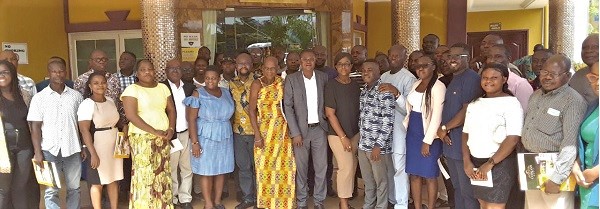
Solving galamsey menace: Land Restoration Project engages stakeholders
The Ghana Landscape Restoration and Small Scale Mining Project (GLRSSMP) under the Ministry of Lands and Natural Resources has held a meeting with its stakeholders to find a long-term and sustainable solution to issues of illegal mining, also known as ‘galamsey’, which has destroyed most of the country’s lands.
The project seeks, among other things, to enhance the capacities of agencies mandated to regulate mining activities in the country as part of the process of finding workable solutions to the menace.
Advertisement
The project seeks to strengthen the integration of the country’s natural resources and its management to increase the benefits to communities in targeted savannah and cocoa forest landscapes.
It will also support sustainable land, water and forest management initiatives in climate-vulnerable target landscapes and support the formalisation of small-scale mining.
The GLRSSMP geographically targets two landscapes: the Northern Savannah Zone (including the Guinea Savannah ecological zone, the Sudan Savannah ecological zone, and the upper portions of the transitional ecological zone); the cocoa forest landscape (including parts of the forest ecological zone and the Pra River Basin).
It will capitalise on land-use planning for integrated landscape management to optimise land use, formalise artisanal and small-scale mining for sustainable mining, restore degraded lands, promote sustainable agricultural practices and strengthen sustainable management of forest landscapes for biodiversity conservation and ecosystem services.
Sanitising local mining
Addressing the participants from the Central, Ashanti, Western and Western North regions, the National Coordinator of the project, Dr John Kingsley Krugu, said the project would sanitise Ghana’s small-scale mining sector.
He explained that the objective was to ensure that players in the sector mined in a responsible and sustainable manner to preserve the forest reserves and water bodies in the country.
He said the various agencies within the sector had institutional framework to guide operations within the sector but acknowledged that there would be the need for more resources and capacity building to enable them to enforce the laws guiding the industry.
Under the project, the government would bear the cost of exploration where it would map out all areas with mineral deposits, while all small-scale miners would need a licence to mine.
Dr Krugu explained that the objective was to ensure that no foreigners got involved in small-scale mining and concessioners did not destroy the land under the guise of exploring for minerals.
He said the already mapped out mineral concessions would also help small-scale miners to access facilities from the banks to enable them to undertake their mining activities.
The Vice-Chairman of the Dunkwa Small Scale Miners Association, Benjamin Annan, said the project would help the miners by taking away the cost of exploration and appealed to the government not to politicise it.
He said politicisation of the project would undermine its success and force people to revert to the old ways of doing things.
Redress mechanism
Presenting the grievance redress mechanism component of the project, the World Bank Environment Specialist, Wilson Zoogah, said the project had put in place measures to help communities and individuals who may have issues with the implementation of the project to seek redress.
He said the mechanism “ensures that appropriate and mutually acceptable redress actions are identified and implemented to the satisfaction of complainants and avoids the need to resort to judicial proceedings”.



